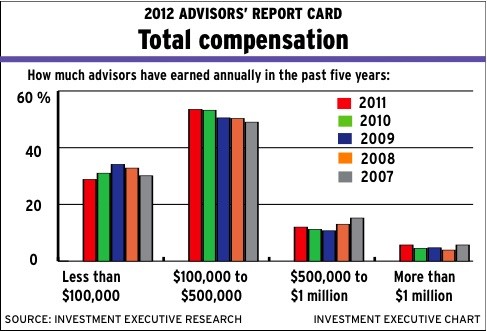Financial Advisor Compensation Options
Post on: 7 Июль, 2015 No Comment

There are a handful of financial advisors in Canada that are salary only. They do not receive bonuses or commissions on top of a base salary. These are pretty rare.
Pros
- Advisor has no conflict of interest to put you into any one product
- May have low investment minimums
Cons
This is the normal structure you will find at the bank branch level. These in-house financial advisors will be paid a base salary and can earn a bonus that can double their base salary. The bonus is essentially based on a number of factors such as the number of dollars they had clients transfer in to mutual funds, GICs, bank accounts, etc. They may get rewarded for bringing in business to other areas of the bank such as the mortgage department, creditor insurance policies, referring up to the full service brokerage, etc.
Pros
Cons
There are a number of different commission based advisors out there. On the investing side, some only offer mutual funds and GICs, some offer those as well as stocks and bonds and other securities (hedge funds, options, etc.), and some also offer segregated funds. Its quite varied, and the commission based option is quite common. It is also worth noting that there is a spectrum of options available within the commission based model. Some advisors may use DSC funds (deferred sales charge mutual funds these pay an upfront commission, 5% maybe, and a small ongoing commission every year of 0.50%), and others may use front-end funds (and choose to charge 0% up-front but the front end funds may pay a higher ongoing trailing commission of 1.00%). Other advisors may use front-end funds and choose to charge you 2% off the top (which clearly shows up as your up-front fee as opposed to DSC funds which wont reflect this on your statement). Other advisors may simply charge you a commission to buy and sell stocks and they may be active traders, or buy and hold proponents. At the end of the day, as an investor you need to know how much you are paying for what in order to help figure out if you are getting appropriate value.
Essentially, there are lots of different sub-categories within the commission based model. I present the general pros and cons of this model, but it is worth having a conversation with your advisor / potential advisor about these options if you choose to go this route. (Im a firm believer that just by having these conversations candidly with an advisor is going to tell you more about them then the model they operate under).
Pros
- Advisor is rewarded for actively finding and identifying opportunities to improve peoples financial situations
- Advisor can be rewarded when investment recommendations work (income goes up when your portfolio grows and income decreases when your portfolio decreases)
- Experienced advisor can get adequately compensated for working with newer/smaller clients, client may have access to higher quality knowledge/product shelf than at bank branch level
Cons
- Advisor has conflict of interest: can be focused more on product than the person, may recommend investing over debt reduction due to compensation difference (for example)
- Fees embedded in products means its harder to determine what you are paying for products and what you are paying for advice
- Advisor may be more motivated to start relationship and less motivated to maintain relationship if using front loaded products these would be products like DSC mutual funds or insurance policies which pay large commissions up front but smaller ongoing commissions
- Advisors can be incentivized to use higher risk products (as higher risk products can pay higher commissions)

You may want to read this primer on how mutual fund sales are compensated in Canada its complex, but it gives you the basics.
Technically the fees earned by fee-based advisors are Client Advisory Fees, and this fee might be based on a flat percentage of the portfolio size as opposed to being more transactional in nature. Also, fee-based advisors have a more transparent fee structure as the fees always show up explicitly on your statement. For example, if you have a $500,000 portfolio and you have agreed to a fee of 1.00% per year, you might see $1,250 clearly charged to your account every quarter ($5,000/year). All transactions may be covered by this fee, regardless of what products you have in your account. Further, for non-registered accounts this fee may be tax deductible (always check with a tax professional first).
Fees may be tiered, meaning they are reduced as your portfolio grows. They may also be set at different levels for equities versus fixed income in this case it is important to realize that this creates a conflict of interest in that there is an incentive to increase the equity allocation in a portfolio (and therefore the risk). Ideally, to reduce this conflict you may want to consider asking for the same fee rate applied to equities and fixed income. All of these variables are negotiated and agreed to in writing so it will all be spelled out.
Pros
- Fees are transparent, making it easier to see what you are paying for advice
- Advisor can be rewarded when investment recommendations work (income goes up when your portfolio grows and income decreases when your portfolio decreases)
- Can reduce costs versus traditional commission based options as the cost for advice is negotiable and potentially tax deductible to the client
Cons
- Advisor may have a high minimum portfolio size requirement, almost always in the 6-figure range
- Some advisors only offer investment management and others offer financial planning on top of investment management need to make sure you are comparing apples to apples. Investment management and financial planning at 1.25% might be better than just investment management at 1.00% (for example)
- Product fees (ETF MERs and F-Class Mutual Fund Unit MERs) still need to be added to Client Advisory Fee to calculate total costs (MERs are embedded in product and not readily transparent). For example, a portfolio manager who will run a portfolio of stocks and bonds for 1.25% might be cheaper than someone who charged 1.00% but uses ETFs or F-class mutual fund units which have embedded costs of 0.50% (for a total of 1.50%) but also note that cost is not sole determinant of portfolio performance
The most often associated fee-only model is the straight fee only model in which you either pay by the hour, or pay a flat project fee. This would normally require that the investor be prepared to implement the recommendations on their own, and so would indicate a certain working knowledge required of investing and personal finance and the desire to take direct part in the execution. There are also two other models that fall under the fee-only umbrella which are worth briefly mentioning:
A. Commission Offset This is when the investor chooses to have the advisor also implement the plan. Any commissions generated by products to the advisor serve to rebate the fee charged for the plan. If commissions are greater than the plan fee, the advisor keeps the excess.
B. Fee + Commission This is where there is no offset. You pay a fee for the plan and advice, and then if you also decide to use the advisor to execute the plan they can also generate commissions.
The pros and cons are specifically addressing the straight fee only model. By now, Im sure you can identify some of the pros and cons to the Commission Offset and Fee + Commission models on your own.
Pros
- Fees are transparent, making it easier to see what you are paying for advice
- Substantially eliminates conflict of interest between products and advice
- May be the least expensive option for medium to larger portfolios
Cons
- Advisor may have less ongoing interest in your portfolio and/or financial plan (especially if you decide not to pay them annually for a checkup!)
- Advisor could draw out amount of billable hours if using an hourly model
- Some types of fee-only options not affordable to new/small investors who prefer this approach
- May require more hands-on activity/comfort level by investor to implement recommendations on their own
- Investors may not retain understanding of recommendations over longer periods of time and this may cause them to inadvertently stray from the plan
Extra Note about Fee-Only:
I received some wonderful input from Dan Hallett who is a very highly respected figure in the financial services community in Canada:
Preet, regarding fee-only option in your recent blog post, it might be worth nothing that this is a theoretical option. This is not an option for investors looking for individualized investment advice.
For six years, I offered investment advice to individuals through detailed investment policy statements on a fee-only (hourly billing) basis. I never planned for this to be my primary business so I never advertised it (other than some info on my website). Lots of people, even fee-only/fee-based advisors, told me I’d never make money with that model. They were wrong. When you build a business from day one with that model in mind, it can work – or at least it used to work.
In my six years of offering this service, I never once found another firm or individual who a) had a license to give investment advice based on individual circumstances; and b) charged for this advice on an hourly, retainer or flat dollar fee model. Lots of “financial planners” fall into the latter group but I never found any that were licensed. And I wanted to find them because people outside of Ontario would call or e-mail wanting me to help them and I couldn’t. I called around and searched the net looking for places to refer them to and I never found one anywhere in Canada.
But registration reform has effectively made this nearly non-existent model a virtual impossibility. With higher costs of complying with the new rule, charging by the hour, retainer or flat fee is just not going to work. It had nothing to do with my decision to merge with HighView but I can tell you that I would have had some hard decisions to make had I remained on my own. I would have been faced with either relinquishing the registration. raising the hourly fee substantially or switching to an asset based fee structure.
So, while it’s worth including fee-only in your discussion, I would highlight that it’s just not something that people are likely to find. But I’d love to be proven wrong…
Dan Hallett, CFA, CFP
Dan also wrote more about it on his blog you can read it here .














